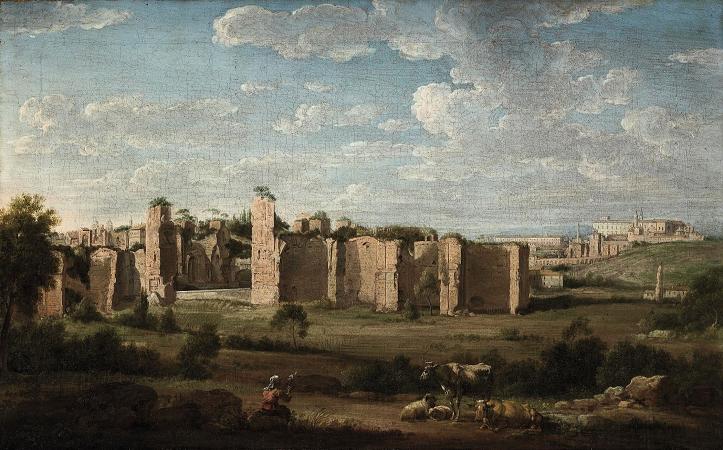Baths of Caracalla (216). The Baths of Caracalla in Rome, Italy, were the city's second largest Roman public baths, or thermae, likely built between AD 212 and 216/217, during the reigns of emperors Septimius Severus and Caracalla. They were in operation until the 530s and then fell into disuse and ruin. However, they have served as an inspiration for many other notable buildings, including the Baths of Diocletian, Basilica of Maxentius, the original Pennsylvania Station and Chicago Union Station. Art works recovered from the ruins include famous sculptures such as the Farnese Bull and the Farnese Hercules. Today the Baths of Caracalla are a tourist attraction. Construction of the baths was probably initiated by emperor Septimius Severus and completed during the reign of his son, Caracalla. They were inaugurated in AD 216. The baths were located in the southern area of the city, Regio XII, where members of the Severan family commissioned other construction works: the via nova leading to the baths and the Septizodium on nearby Palatine Hill. For work to have been mostly completed in the time of Caracalla, workers would have had to install over 2,000 metric tons of material every day for six years in order to complete it between 211 and 216. Work on additional decorations continued under Caracalla's successors Elagabalus and Severus Alexander. The baths were likely mostly finished by 235. Later renovations were conducted under Aurelian and by Diocletian. Under Constantine the Great the caldarium was modified. The building was heated by a hypocaust, a system of burning coal and wood underneath the ground to heat water provided by a dedicated aqueduct. The baths were free and open to the public. The baths were fully functional in the 5th century when they were referred to as one of the seven wonders of Rome. Olympiodorus of Thebes mentions a capacity of 1,600. This is interpreted to refer to the maximum number of simultaneous visitors, as the daily capacity is thought to have been 6,000 to 8,000 bathers. The baths remained in use until the 6th century. In 537 during the Gothic War, Vitiges of the Ostrogoths laid siege to Rome and severed the city's water supply. Shortly thereafter the baths were abandoned. Located too far away from the still populated area of Rome, the baths were mostly disused but in the 6th and 7th centuries were apparently used for the burials of pilgrims who died after being cared for in the nearby Xenodochium of Santi Nereo ed Achilleo. Some simple tombs from this era have been found inside the bath area. Popes Adrian I, Sergius II and Nicholas I may have had some work done on the aqueduct through the 9th century. The earthquake of 847 destroyed much of the building, along with many other Roman structures. At least since the 12th century the baths were used as a quarry for construction materials, and of decorative pieces to be reused in churches and palaces. During the 14th century, the area was used as vineyards and gardens. In the mid-16th century Pope Paul III had excavations conducted in the area during the construction of his new villa. In 1545-7 many large statues, made of marble and bronze, were recovered from the ruins. Later during the 16th century, the pope granted the area to the Roman Seminary of the Jesuits. It was used as a playground for children. Philip Neri may have brought children from his oratory here-he is believed to have commissioned the fresco Madonna supported by an angel still located in the natatio. Between the 16th and 18th century interest in the structure was rekindled and several famous architects made drawings of the ruins. The aqueduct serving the baths was in use up to the 19th century. The Aqua Antoniniana aqueduct, a branch of the earlier Aqua Marcia also worked on under Diocletian, was specifically built to serve the baths. In 1824, excavations at the baths were conducted by Count Egidio di Velo, whose findings included the mosaics showing athletes now at the Vatican Museums. Further work followed by Luigi Canina in the frigidarium and then by Battista Guidi. From 1866 to 1869 restoration work in the central part of the complex revealed a torso of Hercules, porphyr columns and figure-adorned capitals. In 1870 the area became the property of the Italian government and Pietro Rosa conducted excavations in the eastern palaestra. In 1878/9, Giuseppe Fiorelli discovered mosaics in the caldarium and western palaestra. From the early 20th century, excavations expanded into the outer areas of the complex and downward, revealing the subterranean passages, including a mithraeum.
more...








